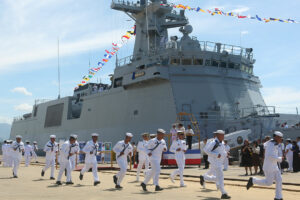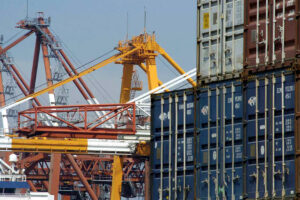Philippines flags Chinese research vessels in exclusive economic zone

By Kenneth Christiane L. Basilio, Reporter
THE Philippine Coast Guard (PCG) on Tuesday said it had detected two Chinese deep-sea research vessels in waters within the country’s exclusive economic zone, raising suspicions that the data collected could be strategically used by the Chinese Navy.
The Philippines detected the vessels using Canada’s vessel detection system, PCG spokesman Jay Tristan Tarriela told a news briefing. One was spotted near the shores of Ilocos Norte province in the north, while another was located off the western province of Palawan facing the South China Sea.
“We can just speculate about the real intent of the Chinese government, why they are sending these Chinese research vessels,” he said. “But one thing is clear: they are violating our exclusive economic zone.”
“These Chinese research vessels are always considered to be for dual-use purposes. They can be scientific but can also be used by the military for submarine navigation,” he added.
The Chinese Embassy in Manila did not immediately reply to a Viber message seeking comment.
Chinese research vessels have repeatedly been spotted within the country’s exclusive economic zone. The PCG in early May expelled a Chinese ship conducting illegal research near Ilocos Norte.
Authorities identified the 87-meter research ship Tan Suo Er Hao entering the Philippines’ exclusive waters on May 17. It was last spotted 130.5 nautical miles (241 kilometers) off the coast of Burgos, Ilocos Norte on Tuesday.
The Chinese research ship did not respond when the PCG sent a plane to challenge its presence, Mr. Tarriela said. “As what we always expect, they never respond to our radio challenges.”
Meanwhile, the 100-meter Xiang Yang Hong 302 was spotted about 180 nautical miles off Rizal, Palawan also on Tuesday. It is operated by China’s oceanography agency, Mr. Tarriela said.
He added that the research vessel was first detected on Monday near Union Banks, an atoll within the contested Spratly islands in the South China Sea.
The Philippines and China have repeatedly locked horns over maritime features that both nations claim in the disputed sea, leading to maritime confrontations that involve the use of water cannons and repeated sideswipes by Chinese vessels against Philippine ships.
Manila has condemned such acts as aggressive and unlawful, while Beijing maintains its actions are meant to defend Chinese sovereignty.
China claims nearly all of the potentially mineral- and oil-rich South China Sea based on a 1940s nine-dash line map that stretches into Southeast Asia and overlaps with the exclusive waters of the Philippines and regional neighbors like Vietnam and Malaysia.
Beijing’s increasing assertiveness in the waterway has startled Manila’s allies and fueled security concerns.
“Despite tensions in our region… we stand firm,” Philippine President Ferdinand R. Marcos, Jr. said in a speech at the Philippine Navy’s 127th founding anniversary in Subic, Zambales, based on a transcript from the Presidential Communications Office.
“We will never tolerate any act of disrespect against our sovereignty,” he added.
Also on Tuesday, the Philippine Navy commissioned two new warships during its anniversary celebration.
The South Korean-made missile frigate BRP Miguel Malvar and locally built fast-attack vessel BRP Albert Majini were commissioned during ceremonies led by Mr. Marcos and Philippine Navy chief Vice Admiral Jose Ma. A. Ezpeleta at the Naval Operating Base in Subic.
“[The] navy has steadily grown into a force that is ever prepared to protect the country,” Mr. Ezpeleta said, based on a YouTube livestream. “Our readiness has become even more crucial in navigating the present security environment filled with urgent challenges related to the development in our seas.”
“And for the Philippines, we are aware that our country’s future is linked to the security of our maritime domain,” he added.
The Philippine Navy is seeking to increase its fleet of modern warships and patrol vessels as it grapples with China’s naval might in the South China Sea.
Measuring 118-meters, the BRP Miguel Malvar, the namesake of its class ship, is armed with missiles and torpedo systems and fitted with sonar, radar and electronic warfare capabilities.
BRP Albert Majini is the latest addition to the navy’s 32-meter Acero-class gunships for coastal patrols and is equipped with missile systems and machine guns.



